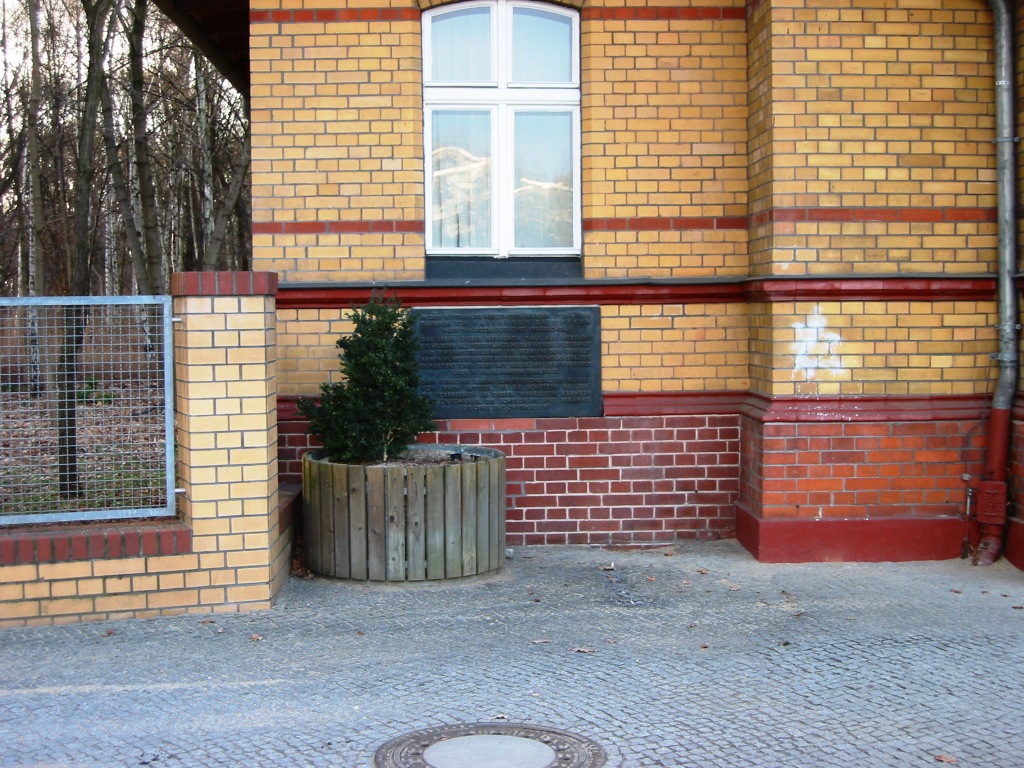Home
Berlin-Wittenau (Städtische
Nervenklinik für Kinder ["Wiesengrund"])
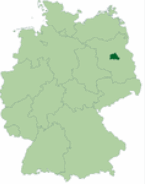
The special children's ward was located in the Municipal
Psychiatric Clinic for Children, called "Wiesengrund." It became
independent from the main facility in Wittenau that it had previously
been a part of on 1 July 1941. The main facility in Wittenau had
operated as "Wittenauer Heilstätten,
Nervenklinik für Kinder. Angeschlossen: Erziehungsheim mit Hilfsschule.
Entwicklungsgestörte,
fortbildungsfähige
Kinder im Alter von 7 bis 15 Jahren" (Wittenau Care Facilities:
Psychiatric Clinic for Children: Included: Educational Facility with
Special Education School: Developmentally Delayed Children Who Can Be
Educated in the Ages of 7-15) in its letterhead and consisted of an
educational facility (Erziehungsheim) with a special needs division
(heilpädagogische
Abteilung)
and a special education school (Sonderschule) as well as a
neurological-psychiatric department and a policlinic (for the
convoluted history, see Beddies and Schmiedebach 2004, pp. 167-9). The
newly independent clinic comprised two physically separate entities: the
educational facility with a school of special education as well as the
clinical division I (this included the policlinic), housed at the site
of the Wittenauer Heilstäten;
and the second entity, the clinical divisions II and III, which
included the psychiatric division (see also Schmuhl, p. 235 n. 264).
This entity was located in two pavilions of the former Dalldorf
farmyard, which since 1929 were used as the "Psychiatric Facility for
Men" and underwent construction upgrades financed by the
Reichsaussschuss. The special children's ward was located in house
B/division III. As a result of aerial bombings, a part of the clinic
was transferred to to Bad Freienwalde in the children's facility there
in 1943. After WWII, the buildings continued to be used for the city.
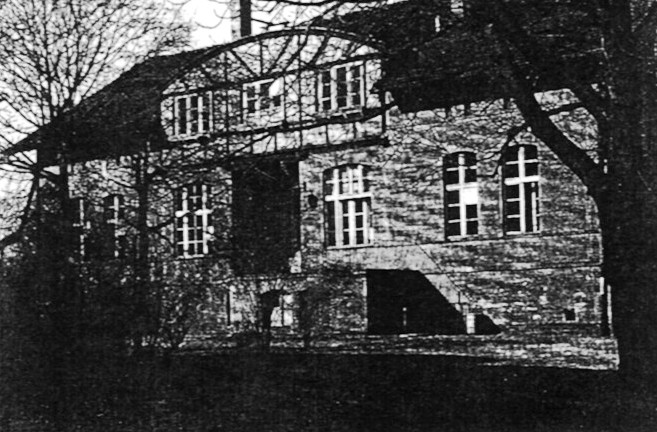 Source: Krüger, p. 157
Source: Krüger, p. 157
Dr. Dr. Ernst Hefter was responsible for the clinic as a whole.
Responsible for the special children's ward was Dr. Gertrud Reuter, who
assumed her position in March 1942 and was responsible for division
III. Dr. Gerhard Kujath was responsible for division II and carried out
medical examinations and experiments with the children of the special
children's wards.
Dr. Hefter was arrested by the Soviet occupational power and received
in 1946 received a sentence of ten years in prison for providing 55
assessments leading to sterilization and having "put to sleep" 30
children. He died in prison in 1947. Since Dr. Hefter had previously
died, the state attorney's office in the 1906s in Berlin
concluded its investigations against Dr. Hefter and his associates,
which commenced after a former inmate of the Erziehungsheim had filed a
criminal complaint, without moving to trial. Dr. Reuter was not
investigated. Dr. Kujath and others disclaimed any involvement in
"euthanasia." The court noted that "indications of suspeicious
circumstances" were considerable but not sufficient to demonstrate that
he was assisted in his deeds by others. From this time dated the
declaration of the administration of the Karl-Bonhoeffer-Nervenklinik,
as the successor to the "Wiesengrund," that both administrative and
patient records were no longer extant. Dr. Reuter left Berlin at the
end of February 1945 and worked in Essen as a specialist for neurology
an psychiatry between 1947 and 1975. She died there in 1999. Dr. Kujath
became
head of the Pediatric Psychiatric Department at the Children's Clinic
of the Free University Berlin and was a well-regarded expert in this
field. He died in 1978.
On occasion of its 100th anniversary, the Karl-Bonhoeffer-Nervenklinik
published a commemorative book in 1980, which alluded to the period of
1933-1945 in a single sentence (Karl-Bonhoeffer-Nervenklinik 1980). In
his medical dissertation in 1982, Wolfgang Stender claimed that no
patient records existed and stated that no killing of children could be
confirmed. A commemorative publication of the clinic in 1982 (Machineck
et al. 1982) came to the same conclusion.
Source: author; http://freenet-homepage.de/museumkesselhaus/html/totgeschwiegen_1.html
In 1984 a group of staff formed at the Karl-Bonhoeffer-Nervenklinik on
the initiative of the director Dr. Bernd-Michael Becker to address the
history of the clinic under National Socialism. The members of this
group included Sabine Damm, Norbert Emmerich, Ursula Grell, Christina
Härtel, Marianne Hühn, and Martina Krüger. Their activities led to the
rediscovery of patient records as well as a book Totgeschwiegen: 1933-1945
and exhibit of the same name. The exhibit was one of the earliest
exhibits on the topic of "euthanasia" that now has been recently
resurrected (see exhibits). It included a detailed section on "euthanasia" crimes and
an account of the murders at the Kinderfachabteilung at "Wiesengrund."
Martina Krüger's essay in the book established that 175 children had
been "Reichsausschusskinder" in the special children's ward, for whom
159 medical records were found. 81 children of these children died in
the clinic, and 14 of them in an affiliated home. The essay notes that
the last child was admitted by the Reichsausschuss in January 1945, and
it includes a reference to a child that had been admitted in
mid-January 1942. More recent research of Thomas Beddies and
Heinz-Peter Schmiedebach has not only confirmed the initial findings
but also demonstrated that before the special children's ward was
opened, 167 children at the Wittenauer Heilstätten
were transferred to Brandenburg-Görden (itself the location of a
special children's ward), whence 19 were sent to a T4 gassing facility.
118 of the children died in Brandenburg-Görden (without being linked to
T4 or the Reichsausschuss), and seven children were transferred to the
"decentralized euthanasia" facilities Hadamar and Meseritz/Obrawalde
after T4. At least 41 minors (and perhaps twice as many) were
transferred directly from the Wittenauer Heilstätten to Meseritz/Obrawalde and
murdered there. Moreover, many of the children at the Wittenauer Heilstätten were subjected to
horrendous forms of medical experimentation and research.
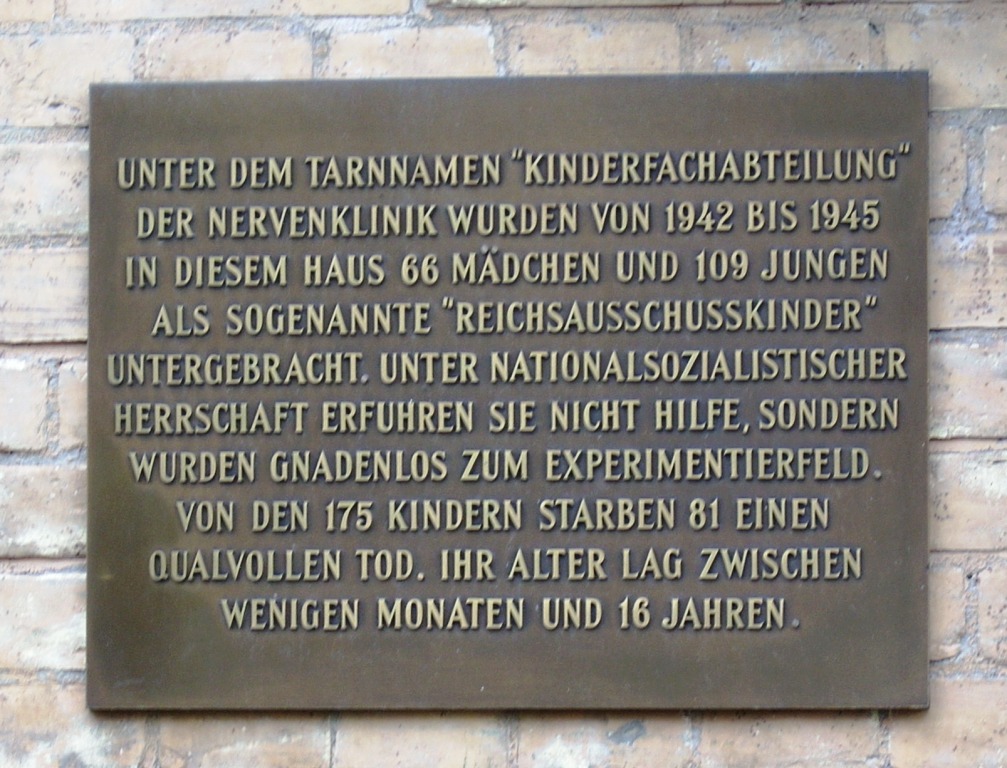 Source: author
Source: author
In 1993 a commemorative plaque has been placed on the building that housed the
special children's ward (its location was moved in 2007). It reads: "Under the guise of a 'special
children's ward' of the psychiatric clinic 66 girls and 109 boys were
placed here in this building as 'Reichsausschusskinder' between 1942
and 1945. Under National Socialist rule they received no assistance
but were used for supply for experimentation without mercy. Of the 175
children 81 died a painful death. Their age was between a few months
and 16 years." Annually, a commemorative wreath has been placed there.
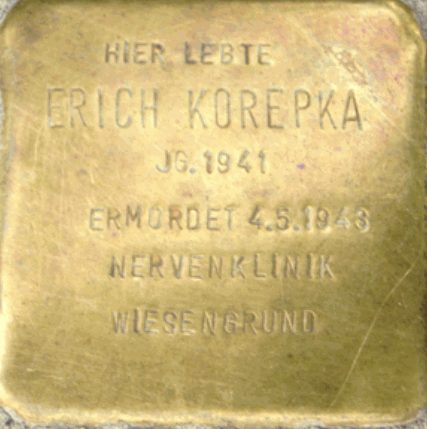 Source: http://www.berlin.de/imperia/md/content/bareinickendorf/abteilungen/gessoz/stolpersteine_seite_31bis40.pdf
Source: http://www.berlin.de/imperia/md/content/bareinickendorf/abteilungen/gessoz/stolpersteine_seite_31bis40.pdf
There are also several stumbling blocks placed there (see here).
Sources:
http://de.academic.ru/pictures/dewiki/71/Gedenktafel_Euthanasieopfer_KaBoN.jpg;
http://commons.wikimedia.org/wiki/File:Gedenktafel_Oranienburger_Str_285_%28Witte%29_NS_Opfer_.JPG
In 1994 a commemorative display for the victims of "euthanasia" in
general was placed at the entrance of the facility of the Wittenauer
Heilstätten.
It reads: "In the Wittenau healing facility thousands of patients fell
victims to National Socialist crimes between 1933 and 1945. The
lives of these persons were considered to be without value. They were
termed unworthy to procreate and compulsorily sterilized. They died of
starvation by force, were transported to killing facilities and
murdered there with drugs or in gas chambers. These persons were
entrusted to the facility. They were killed by those who were supposed
to protect them. The crimes against these defenseless victims cannot be
atoned. The guilty are known to us. The victims are not forgotten."
The recently redesigned and redeveloped exhibit "Totgeschwiegen"
also has a section on "children's euthanasia." The clinic itself, the
Vivantes - Netzwerk für Gesundheit GmbH, does not provide information
about "euthanasia" as part of its history on its website.
A motorcycle club in Berlin made the location of the "Wiesengrund"
clinic a part of its alternative city tour and alluded to the history
of the crimes there on a webpage.
Most recently, students at a Berlin high school put together an exhibit on some of the child victims, as reported here.
Literature
Beddies, Thomas, and Heinz-Peter Schmiedebach.
2004. "'Euthanasie'-Opfer und Versuchsobjekte: Kranke und behinderte
Kinder in Berlin während des Zweiten Weltkriegs." Medizinhistorisches Journal
39(3):165-96.
Benzenhöfer, Udo. 2003. "Genese
und Struktur der 'NS-Kinder- und Jugendlicheneuthanasie.'" Monatsschrift für Kinderheilkunde
151: 1012-1019.
Krüger, Martina. 1989. "Kinderfachabteilung
Wiesengrund: Die Tötung behinderter Kinder in Wittenau." Pp. 151-76 in Totgeschwiegen 1933-1945: Zur Geschichte
der Wittenauer Heilstätten, seit 1957 Karl-Bonhoeffer-Nervenklinik,
edited by the Arbeitsgruppe zur Erforschung der Geschichte der
Karl-Bonhoeffer-Nervenklinik. 2d ed. Berlin: Edition Hentrich.
Karl-Bonhoeffer-Nervenklinik, ed. 100 Jahre
Karl-Bonhoeffer-Nervenklinik 1880–1980. Berlin-Reinickendorf:
Karl-Bonhoeffer-Nervenklinik.
Machinek,
Uwe; Eberhard Hartisch, and Heinz Naegler, eds. 1982. Denkschrift zum 100jährigen Bestehen der
Klinik
Wiesengrund.
Berlin-Reinickendorf: Humboldt-Krankenhaus.
Endlich, Stefanie, Nora Goldenbogen, Beatrix Herlemann, Monika
Kahl, and Regina Scheer. 2002. Gedenkstätten
für die Opfer des Nationalsozialismus, vol. 2. Bonn: Bundeszentrale für politische Bildung. Available at http://www.bpb.de/files/AFQX24.pdf.
Schmuhl, Hans-Walther. 2005. Grenzüberschreitungen: Das
Kaiser-Wilhlem-Institut für Anthropologie, menschliche Erblehre und
Eugenik, 1927-1945. Göttingen: Wallstein.
Stender, Wolf. 1982. "Hundert Jahre 'Klinik
Wiesengrund': Eine medizinhistorische Untersuchung zur Entwicklung der
Kinder- und Jugendpsychiatrie." Medical Dissertation, Freie Universität
Berlin.
Topp, Sascha. 2004. “Der ‘Reichsausschuss zur
wissenschaftlichen Erfassung erb- und anlagebedingter schwerer Leiden’:
Zur
Organisation der Ermordung minderjähriger Kranker im
Nationalsozialismus 1939-1945.”
Pp. 17-54 in Kinder in der NS-Psychiatrie,
edited by Thomas Beddies and Kristina Hübener. Berlin-Brandenburg:
Be.bra
Wissenschaft.
———. 2005. "Der 'Reichsausschuß zur
wissenschaftlichen Erfassung erb-
und anlagebedingter schwerer Leiden': Die Ermordung minderjähriger
Kranker im Nationalsozialismus 1939-1945." Master's Thesis in History,
University of Berlin.
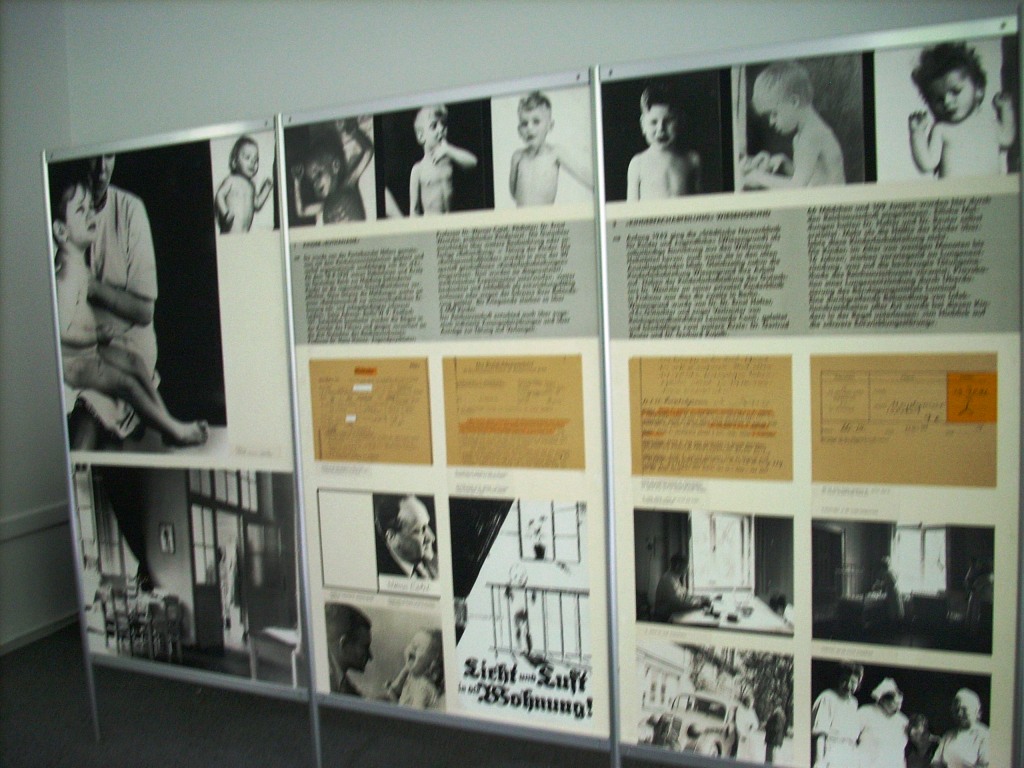
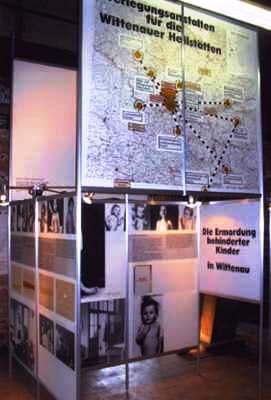

 Source: Krüger, p. 157
Source: Krüger, p. 157

 Source: author
Source: author Source: http://www.berlin.de/imperia/md/content/bareinickendorf/abteilungen/gessoz/stolpersteine_seite_31bis40.pdf
Source: http://www.berlin.de/imperia/md/content/bareinickendorf/abteilungen/gessoz/stolpersteine_seite_31bis40.pdf